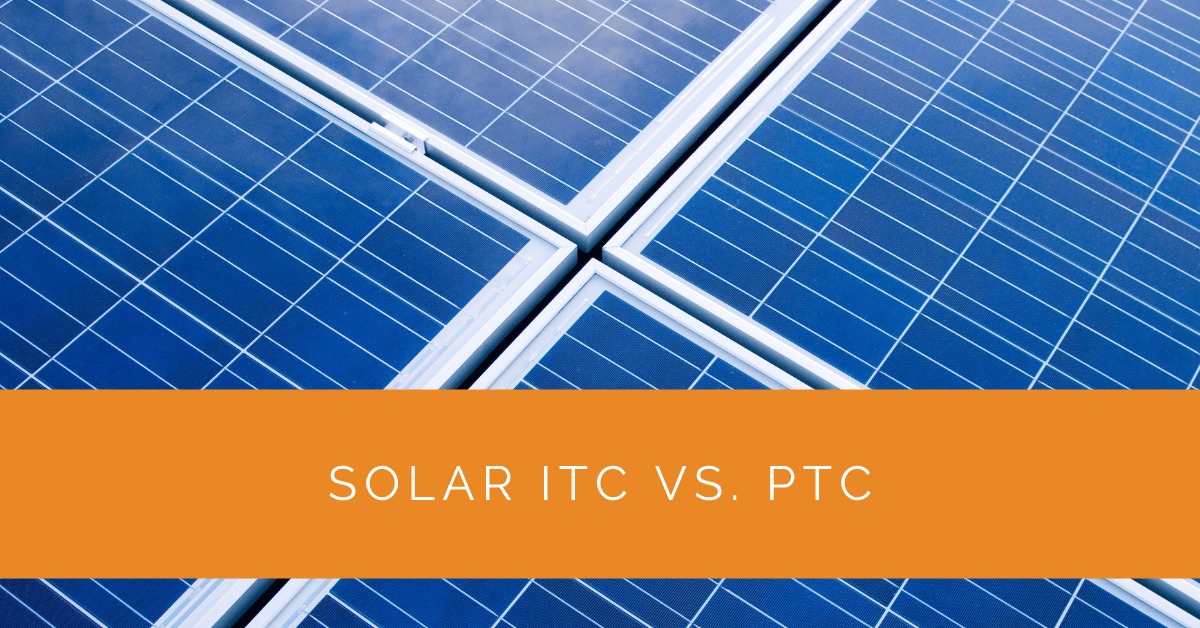Various incentives, including tax credits, have fueled the solar industry’s growth. Two significant tax credits available for solar projects are the Solar Investment Tax Credit (ITC) and the Production Tax Credit (PTC). This article will delve into the details of these tax credits, their implications for solar developers, and the factors to consider when selecting between them.
Contents
- 1 Key Takeaways
- 2 The Basics: Solar ITC and PTC Explained
- 3 Comparing Solar ITC and PTC
- 4 Commercial Solar and Tax Credits
- 5 Domestic Content Bonus: An Additional Incentive
- 6 Case Study: Leveraging ITC and PTC for Optimal Solar Project Development
- 7 Expert Insights From Our Solar Panel Installers About Solar ITC vs. PTC
- 8 Experience Solar Excellence with Us!
- 9 Conclusion
- 10 FAQ
Key Takeaways
- The Solar Investment Tax Credit (ITC) and Production Tax Credit (PTC) are significant federal tax credits incentivizing investment in solar power and renewable energy projects.
- The ITC focuses on upfront installation costs, while the PTC provides a tax credit based on the energy produced by eligible projects.
- Factors such as project characteristics, financial goals, and regulatory conditions should be considered when selecting between the ITC and PTC to maximize the benefits of tax credits in solar power projects.
The Basics: Solar ITC and PTC Explained
Solar Investment Tax Credit (ITC)
The Solar Investment Tax Credit, or the ITC, is a federal tax credit designed to incentivize investment in solar energy projects. Under the ITC, individuals, and businesses that install solar energy systems can claim a percentage of the installation costs as a tax credit.
Unlocking the Power of Solar ITC
The ITC has played a crucial role in driving solar industry growth. It provides a substantial upfront incentive, allowing solar project developers to offset a significant portion of their installation costs. The ITC has been a driving force behind the rapid expansion of the solar industry in the United States.
Production Tax Credit (PTC)
The Production Tax Credit, commonly called the PTC, is a federal tax credit promoting renewable energy projects, including solar and wind. Unlike the ITC, which focuses on upfront installation costs, the PTC provides a tax credit based on the energy produced by eligible renewable energy projects.
Harnessing the Benefits of Production Tax Credit
The PTC offers a tax credit per kilowatt-hour (kWh) of electricity generated by qualifying solar or wind projects. The credit is available for a specified period, typically ten years, and is based on the actual energy production of the project. This incentivizes developers to focus on the long-term energy production and operation of their renewable energy projects.

Comparing Solar ITC and PTC
Key Differences and Similarities
While the ITC and PTC are designed to incentivize renewable energy projects, their focus and eligibility requirements differ. The ITC emphasizes the upfront installation costs, providing a percentage-based tax credit. In contrast, the PTC centers around the project’s energy production, offering a credit per kilowatt-hour generated.
Despite their differences, both tax credits have played vital roles in driving the solar industry’s growth. They have been instrumental in attracting investments, creating jobs, and advancing the adoption of renewable energy.
Choosing the Right Tax Credit: Factors to Consider
Selecting between the ITC and PTC requires careful consideration of various factors. These include project characteristics, tax equity considerations, financial goals, and regulatory conditions. Evaluating these factors will help solar developers determine which tax credit aligns best with their specific needs and objectives.
Commercial Solar and Tax Credits
Implications for Solar Developers
For commercial solar developers, understanding the implications of tax credits is crucial. The availability of the ITC and PTC significantly influences project economics and financial feasibility. Developers need to navigate the complexities of tax equity financing, partnership structures, and project timelines to maximize the benefits of these tax credits.
Leveraging Tax Credits in Commercial Solar Projects
Solar developers can leverage tax credits to attract tax equity investors and secure project financing. Tax equity investors can utilize the tax credits to offset their tax liability while investing in renewable energy projects. This partnership allows developers to access capital and accelerate project development, contributing to the solar industry’s growth.

Domestic Content Bonus: An Additional Incentive
Exploring the Domestic Content Bonus
In addition to the ITC and PTC, certain solar projects may be eligible for a Domestic Content Bonus. This bonus provides an additional incentive for projects that meet specific domestic content requirements. It encourages the use of domestically manufactured components and promotes the growth of the domestic solar industry.
Maximizing Benefits with the Domestic Content Bonus
Solar developers should explore the potential benefits of the Domestic Content Bonus and assess whether their projects meet the necessary criteria. By incorporating domestically manufactured components, developers can take advantage of this bonus and further enhance the financial attractiveness of their solar projects.
Case Study: Leveraging ITC and PTC for Optimal Solar Project Development
Background
Solar Panels Network USA recently undertook a large-scale commercial solar project aiming to maximize financial incentives while ensuring long-term energy production efficiency. The project was designed to explore the benefits of the Solar Investment Tax Credit (ITC) and the Production Tax Credit (PTC) to optimize financial returns and support sustainable energy goals.
Project Overview
The primary objective was to integrate a robust solar power system that could leverage both ITC and PTC effectively. This involved detailed planning and analysis to ensure compliance with tax credit requirements and maximize financial incentives. The project also aimed to incorporate domestically manufactured components to explore additional benefits from the Domestic Content Bonus.
Implementation
Initial Assessment and Planning
Our team began with a comprehensive assessment of the project’s financial and technical aspects. We evaluated the project’s characteristics, including expected energy production, installation costs, and potential regulatory conditions.
Selecting the Appropriate Tax Credits
Utilizing the ITC:
- The project took advantage of the ITC, which allowed us to claim a significant percentage of the upfront installation costs as a tax credit. This reduced the initial financial burden and attracted investors looking for immediate tax benefits.
- Detailed documentation of installation costs was maintained to ensure compliance and maximize the tax credit received.
Leveraging the PTC:
- The PTC was utilized for its long-term benefits, offering a tax credit based on the actual energy produced by the solar project. This incentivized sustained high performance and energy efficiency.
- We established robust monitoring systems to track energy production accurately and ensure eligibility for PTC over the specified period.
Incorporating the Domestic Content Bonus
To further enhance financial incentives, we explored the Domestic Content Bonus by integrating domestically manufactured components into the project. This provided an additional layer of financial benefits, supporting local manufacturing and contributing to the project’s overall economic viability.
Results
Financial Optimization
- By leveraging both ITC and PTC, the project achieved substantial financial savings, reducing initial costs and ensuring long-term financial benefits through sustained energy production.
- The inclusion of the Domestic Content Bonus further improved the project’s financial attractiveness, enhancing overall returns on investment.
Enhanced Project Viability
- The dual approach of using ITC for upfront cost reduction and PTC for long-term energy production ensured a balanced and financially sound project structure.
- Attracting tax equity investors was facilitated through the combined incentives, accelerating project development and implementation.
Sustainable Energy Production
- The project successfully maintained high energy production levels, ensuring compliance with PTC requirements and maximizing tax credits based on actual energy output.
- The use of domestically manufactured components supported local industries and contributed to the project’s sustainability goals.
Summary
This case study demonstrates the effective use of Solar Investment Tax Credit (ITC) and Production Tax Credit (PTC) in large-scale solar project development. By carefully planning and leveraging these tax credits, Solar Panels Network USA optimized financial returns, ensured long-term project viability, and contributed to sustainable energy production. The incorporation of the Domestic Content Bonus further enhanced the project’s economic and environmental impact, showcasing the benefits of a comprehensive approach to tax incentives in solar energy projects.
Expert Insights From Our Solar Panel Installers About Solar ITC vs. PTC
Understanding the nuances between ITC and PTC can significantly impact the financial viability of your solar project. The ITC’s upfront cost reduction is a great incentive for those looking to manage initial expenses effectively.
Solar Finance Expert
The PTC offers long-term benefits by rewarding actual energy production, making it an excellent choice for projects focused on sustained performance and energy output.
Renewable Energy Consultant
For commercial projects, leveraging both ITC and PTC, when possible, can optimize financial outcomes and attract more investment, ensuring robust project development.
Senior Project Manager
Experience Solar Excellence with Us!
Trust in Solar Panels Network USA, where our seasoned experts deliver top-quality solar solutions for homes and businesses nationwide. With a legacy of countless successful installations and a commitment to sustainable energy, we’re your reliable partner in the solar journey. Ready for a brighter, eco-friendly future? Call us now at (855) 427-0058 and harness the power of the sun!
Conclusion
The Solar Investment Tax Credit (ITC) and Production Tax Credit (PTC) are essential tools for promoting renewable energy projects, including solar power. Understanding the nuances and implications of these tax credits is crucial for solar developers. By carefully evaluating project characteristics, financial goals, and regulatory conditions, developers can make informed decisions when selecting the ITC and PTC. Leveraging tax credits and exploring additional incentives, such as the Domestic Content Bonus, enables developers to maximize the benefits and drive the solar industry’s growth.
Remember, tax regulations and incentives may vary. It is advisable to consult with tax professionals and stay informed about the latest updates from the Internal Revenue Service (IRS) to ensure compliance and maximize the benefits of tax credits in solar power projects.
FAQ
What are PTC and ITC?
The Solar Investment Tax Credit (ITC) is a federal tax credit that provides a percentage-based incentive for individuals and businesses to invest in solar energy systems. It focuses on upfront installation costs. The Production Tax Credit (PTC) is a federal tax credit that promotes renewable energy projects, including solar and wind. It offers a credit per kilowatt-hour of electricity generated by qualifying projects, emphasizing energy production.
Is PTC better than ITC?
The suitability of PTC or ITC depends on various factors, including project characteristics, financial goals, and regulatory conditions. Each tax credit has its advantages and eligibility requirements. Evaluating these factors will help determine which tax credit suits specific needs and objectives.
Does solar qualify for PTC?
Yes, solar projects can qualify for the PTC. The PTC supports renewable energy projects, including solar power. To qualify, solar projects must meet specific eligibility requirements set by the Internal Revenue Service (IRS) and comply with regulations related to energy production and project timelines.
Remember, it is advisable to consult with tax professionals and stay informed about the latest updates from the IRS to understand the specific qualifications and eligibility criteria for tax credits related to solar projects.
About the Author
Solar Panels Network USA stands at the forefront of solar energy solutions, driven by a team of seasoned solar engineers and energy consultants. With over decades of experience in delivering high-quality solar installations and maintenance, we are committed to promoting sustainable energy through customer-centric, tailored solutions. Our articles reflect this commitment, crafted collaboratively by experts to provide accurate, up-to-date insights into solar technology, ensuring our readers are well-informed and empowered in their solar energy decisions.

